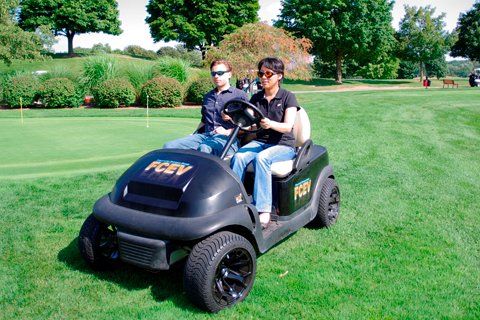Engineering students build hydrogen-powered golf cart
 |
| Faculty adviser Xia Wang and mechanical engineering doctoral candidate, Kris Inman, take a ride in the hydrogen-powered fuel cell golf cart. |
“Hydrogen-based energy allows for an energy infrastructure that has a completely closed, pollution-free chemical cycle,” said Kristopher Inman, president of Oakland’s IAHE chapter. “With hydrogen-based fuel cells, you start with hydrogen and oxygen to get water, and then split that water back into hydrogen and oxygen. Contrarily, gasoline-fueled engines start with gasoline and oxygen, and then emit carbon dioxide, water and other byproducts which remain in earth’s atmosphere.”
The first step of the project was obtaining resources to build the hydrogen-fueled golf cart. To start, Oakland University’s Clean Energy Research Center and OU INCubator provided a used lead acid battery-based golf cart and the School of Engineering and Computer Science Dean’s Office contributed $20,000 in funding for the project. Additional support came from local companies who offered discounts or donated parts and supplies.
“A123 Systems provided us with the main battery pack along with management electronics, and ECD Ovonics provided hydrogen storage canisters at a greatly discounted price,” said Inman, who is a Ph.D. candidate in mechanical engineering. “We also received funding support from the Student Activities Funding Board for various components.”
The group’s faculty advisor, Xia Wang, praised the project for its engineering quality and successful collaboration with university and corporate partners.
“The hydrogen fuel cell-powered golf cart was well-designed and assembled by the students,” Dr. Wang said. “However, it would not have been possible without the SECS Dean’s Office and the businesses that provided the resources to turn the project into reality. This project is a great example of a student organization winning support from both internal and external sources.”
Before installing the hydrogen fuel cell system, chapter members conducted various tests to determine the golf cart’s power draw, top speed and acceleration capabilities.
“We wanted the hydrogen-fueled cart to perform just as well, if not better than the original,” Inman said.
Next, the team removed the cart’s original components and installed the hydrogen fuel cell system. Purchased from Heliocentris Energy Systems Inc., the system provides the vehicle’s motor with 1.2 kW of power and a battery supplies additional power when the vehicle is under high demand. Inman said the company’s leaders were so impressed with the project that they did a case study on it and displayed it on their website.
The vehicle is housed in the OU INCubator and has been included in university outreach events to showcase exciting student-led projects at Oakland. It remains a work in progress for current and future students to hone their skills.
“The project will never be completely done, there’s always room for improvement and things that can be modified and added to make it better,” Inman said. “It’s a great learning tool.”
For additional information on Oakland’s University’s School of Engineering and Computer Science, visit the website at oakland.edu/secs.
